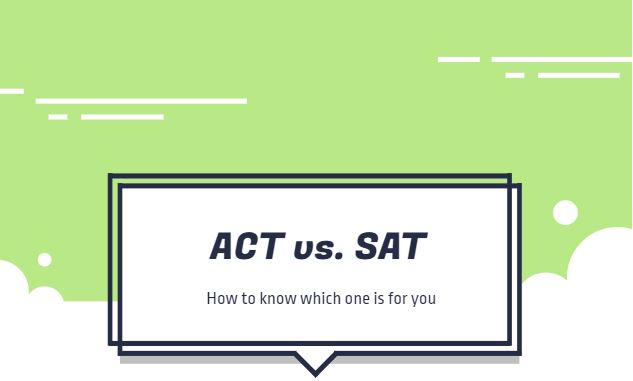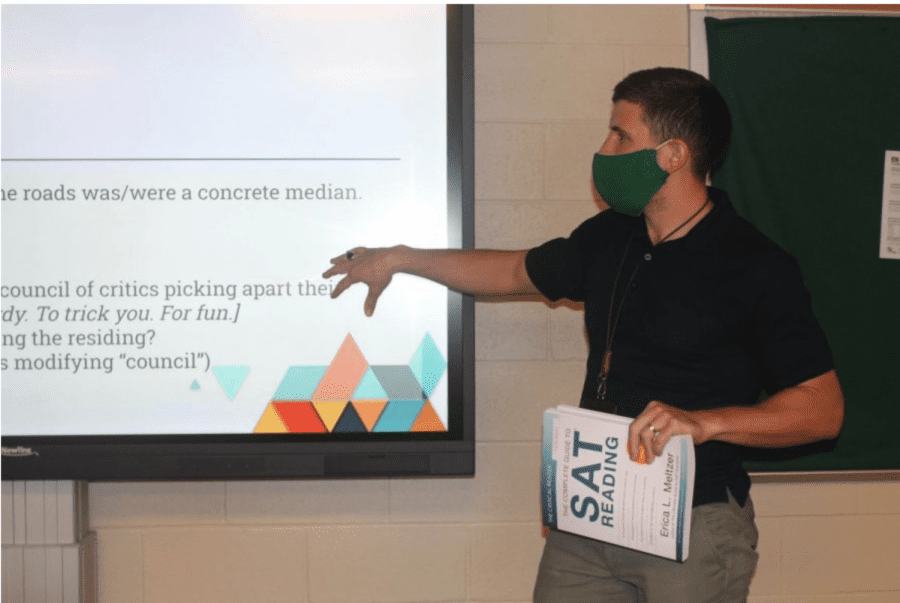From his math-wing Room No. 1134, teacher Thomas Gomez works on his computer before class while wearing his Prosper Eagles face mask. Gomez teaches a PSAT test prep class, as well as Honors Algebra II and AP Calculus AB. Gomez said test preparation and study can help students achieve the results they want on standardized tests. “Typically they improve their ‘Index Score’ by 15 points on average,” Gomez said about his PSAT-prep course participants. “However, we’ve had really invested and hard-working students improve their ‘Index Scores’ by as much as 30 points.”
Class prepares students for October standardized test
To help students improve their PSAT scores, teachers Leith McMillan and Thomas Gomez teach an invite-only test-prep class for juniors.
The class provides students with training and practice tests to prepare them for the PSAT in October, so students can receive National Merit Recognition if they have a high enough score. The class provides students with a 20-hour summer camp, five practice tests with feedback and one-on-one tutoring.
“Typically, they improve their index score by 15 points on average,” Gomez said. “However, we have had really invested and hard-working students improve their index scores by as much as 30 points.”
While the PSAT is scored similarly to the SAT, students can qualify for the National Merit Scholarship based on their PSAT index score. This score is double the sum of their reading, math, writing and language test scores.
“My goal is just to improve overall,” junior PSAT student Makenna Brandvold said. “I hope to receive National Merit Recognition, but my main focus is to develop skills that will make me prepared for the PSAT, SAT and even the ACT.”
National Merit Recognition helps students with college admissions and possible scholarships.
“If invited, I want students to take this class because it only serves to help them,” McMillan said. “The entire purpose of the class is to get better and more comfortable with the format and questions posed by the PSAT, as well as other nationwide tests, and continued practice. This is the best way to get them to make the incremental improvements needed for the highest possible scores. I think the skills assessed in the PSAT go far beyond the test itself, so this prep class can help strengthen reading, writing and math skills in general.”
Students who are current juniors and received an index score of 180 or higher on their practice PSAT from their sophomore year are invited to the class.
“I don’t expect any changes with the index score goals, but I believe how they administer the test may be different due to COVID-19,” Gomez said. “College Board would possibly do something similar to how AP tests were administered online this past spring.”
Gomez suggests that students should start to study and practice for the PSAT as early as possible. He said the College Board’s free online practice tests are helpful as well as PSAT Test Prep Books and Delta Math for the math section.
“If any students want extra resources on the PSAT, but aren’t enrolled in the class, check out the public Google Classroom pages that Mr. Gomez and I created,” McMillan said. “These are open to any Prosper ISD student and contain much of the material we cover in the class, including practice questions, test-taking tips, and more.”
In front of his board in Room 1217, Leith McMillan covers subject-verb agreement while holding an “SAT Reading” section prep book. McMillan teaches the PSAT test-prep class and Honors English II. “The best thing students can do to prepare for the PSAT is get comfortable with things like the types of questions asked, the pacing of the test, and how to approach certain types of questions,” McMillan said. “If a student can at least overcome some of the unfamiliarity of a test, that will help a lot in feeling more at ease and confident about focusing on answering questions.”
PSAT, SAT, ACT resources, tips aid students
With the deadline for college applications approaching, many students are scrambling to apply. Large parts of applications for students are test scores. Students can take the SAT, ACT, or the PSAT/NMSQT and PSAT 10. Each test has a different purpose and while not all are required, it is recommended that a student takes each test at least once.
The PSAT/NMSQT and PSAT 10
This test takes a total of two hours and 45 minutes and is comprised of four sections.
The reading test is 60 minutes long with 47 multiple-choice questions and is based on passages, some paired and some not. There is always:
One passage from a classic or contemporary work of U.S. or world literature
One passage or a pair of passages from either a U.S. founding document or a text in the Great Global Conversation that they inspired
A selection about economics, psychology, sociology, or some other social science
Two science passages that examine foundational concepts and developments in earth science, biology, chemistry, or physics
The writing and language test is 35 minutes long with 44 multiple-choice questions. In this section, students will read passages and fix mistakes. Every question will be based on a passage.
The no-calculator math section is 25 minutes long with 17 questions. The questions are mostly multiple-choice with a few fill-in answers at the end.
The calculator math section is 45 minutes long with 31 questions. Similar to the no-calculator section, the questions are mostly multiple-choice with a few fill-in answers at the end. A list of acceptable calculators for the PSAT can be found on the college board website.
While colleges don’t always use the PSAT scores for applications, it is still useful for students to take. The PSAT helps students qualify for scholarships, specifically the National Merit Scholarship. Students who score high enough can be named as eligible for the National Merit Scholarship where they will then fill out an application to win the scholarship. Every year, there are around 15,000 Finalists and about 8,000 of those students receive Merit Scholarship awards.
Students with an Index Score of over 212 will receive National Merit Recognition and students with an Index Score of over 222 become National Merit Finalists. All Finalists are considered for one of the 2,500 $2,500 scholarships. Besides the National Merit Scholarships, students are more likely to obtain other scholarships if they are given the Merit Scholarship award or are named as a Finalist.
The PSAT test is offered once a year in October and every student’s fees will be paid by their school. This year, the test will occur on October 14, but may change due to COVID-19.
The SAT
The SAT is three hours long, or three hours and 50 minutes long if students take the essay portion, and consists of four parts and an optional essay.
The reading test has 52 multiple-choice questions, is 65 minutes long, and contains questions based on passages and paired passages. The writing and language test has 44 multiple-choice questions, is 35 minutes, and tests students on grammar, vocabulary and their editing skills. The calculator math section has 30 multiple-choice questions and eight fill-in questions in 55 minutes. Acceptable calculators for the math section can be found on the College Board website. The no-calculator math section has 15 multiple-choice questions and 5 fill-in questions in 25 minutes. The optional essay section is 50 minutes long and students must read an essay and explain how the author builds their persuasive argument.
The highest score a student can get is a 1600 and the average score is 1060. The evidence-based reading and writing section can give students 200-800 points, and the math section gives 200-800 points. The evidence-based reading and writing section points can be added to the Math Section points to create the student’s final score. The essay gives students three scores, each ranging from two to eight.
The SAT occurs seven times each year. Specific testing dates can be found on the school website, with the next one occurring at the school on Saturday, Aug. 29, but all dates may be subject to change due to COVID-19. Students can register for the SAT on the College Board website.
The ACT
The ACT consists of four sections with an extra fifth section as well as an optional essay.
The English section has 75 multiple-choice questions, is 45 minutes long and tests a students grammar, punctuation, sentence structure and rhetorical skills. The math section allows students to use an acceptable calculator and has 60 multiple-choice questions in 60 minutes. The math section contains 33 algebra questions, 23 geometry questions, and 4 trigonometry questions.
The reading section has 40 multiple-choice questions in 35 minutes. Students will answer questions based on four passages–prose fiction, social studies, humanities, and natural sciences–with 10 questions per passage. The science section contains 40 multiple-choice questions in 35 minutes and asks questions on science-based passages that are presented with graphs, charts, tables and research summaries. The optional writing section has students write one essay in 40 minutes.
In the fifth test, the ACT tries out sample questions to develop future questions. It is a shorter, multiple-choice test covering one of the previous subject areas. While this test does not affect a student’s scores, students are encouraged to try their best on the questions.
Students can have a maximum ACT score of 36 and the average score is 21.
Students can register for the ACT on the ACT website.
Tips
First, students should eliminate answers that they are sure are wrong. After elimination, students only have to choose between one, two or three answer choices.
Going into the test, students should memorize math equations and formulas as well as common grammar rules. This allows students to complete questions faster and aids with the writing and language section.
Students should never leave questions unanswered. If unsure about the answer, students should guess and choose what they think works best, as there are no penalties for wrong answers.
Students should pace themselves. Students should take their time and not rush through all the questions, but also make sure to watch the timer to so they don’t run out of time.
The workbook is the student’s to use, they should write on it as much as they want. Students should cross out answers, work out equations and underline important information.
In writing and language, students should choose the most concise answer if multiple-choice options are grammatically correct.
In the English section, students should look for direct evidence in the passages or charts. All answer choices have evidence backing it up provided in the passages or charts.
In the math section, when unsure of how to solve an equation, students should guess and check with the answer choices. Students can do this for questions, especially those about solving an equation.
Students should check their answer booklet regularly to make sure they’re filling in the correct answers for the correct question numbers. At the end, if students have time, they need to make sure they filled in all of the answer bubbles correctly.
Resources
One thing not many students know about is the plethora of resources on College Board’s website.
For the SAT, College Board partners with Khan Academy to give students helpful practice for the math section of the test. Furthermore, College Board provides eight free practice tests for students to utilize both online or on paper. With these full-length tests, students can see their scores and receive practice recommendations. Finally, College Board provides some sample questions for students who don’t want to practice with the full-length tests.
For the PSAT/NMSQT and PSAT 10, College Board provides four full-length practice tests that students have to print out and complete on paper. College Board also provides sample questions for students who don’t want to take the full-length tests. While Khan Academy only has SAT practice, College Board recommends utilizing it for the PSAT as well.
The ACT website offers test prep as well. ACT recommends buying their subject guides and beginner guides test prep books. ACT also partners with Kaplan to give students on-demand and live lessons.
Another resource would be test prep books. Students can find these books for the PSAT, SAT and ACT from various companies. The most reliable books would probably come from College Board, ACT, Princeton University, Kaplan or Barron’s Test Prep, which students can easily find on Amazon.



